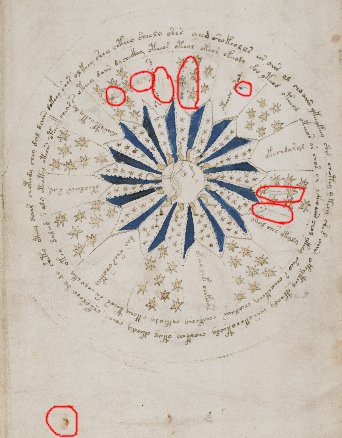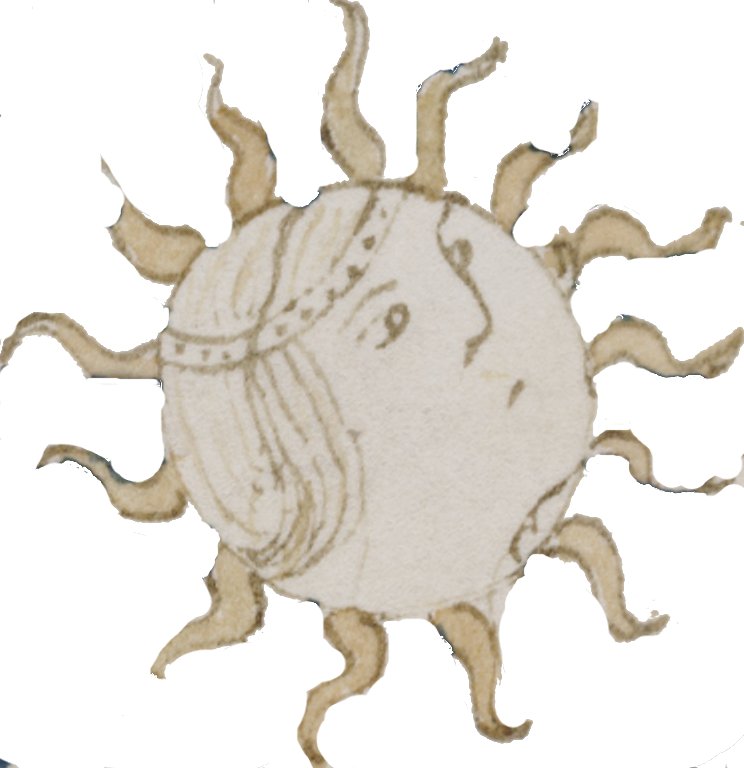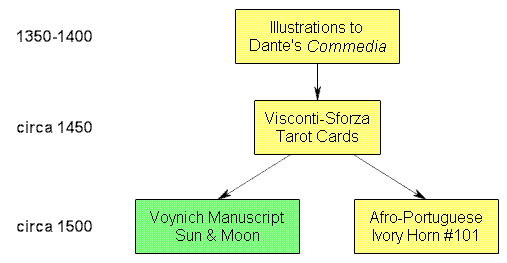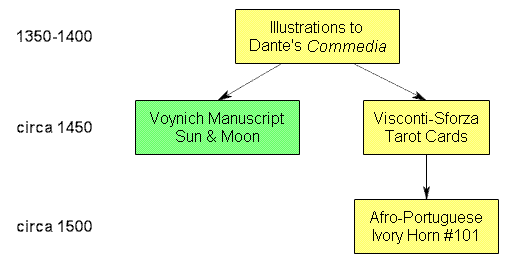My last post on Elmar Vogt’s new blog received a comment from infinitii, asking me for the source for the suggestion that the zodiac motifs may have been copied from a (possibly 14th century) German woodcut calendar. I had long forgotten the story’s origin, but a quick grep through the VMs mailing list archives (the ones before 2002 that aren’t yet on the web) turned up what seems to be the key thread.
Jorge Stolfi began (29Dec2000):-
In the meantime, I remembered I had seen something like the VMS Sagittarius somewhere in the astrological books. And I have found it on the Web – have a look at:
http://www.englib.cornell.edu/mhh4/planets/jupiter.html
This is from an early (15th c.) German “Planets’ Children” blockbooks (the planets’ children theme was also found in some of the Books of Hours – eg. the most beautiful one of Duc de Berry). The crossbow man looks *very much* like the VMS Sagittarius to me. Also note that the actual Sagittarius in a small circle at the feet of Jupiter above is represented as a man – not a traditional centaur (even though he holds a standard bow).
I think this confirms the 15th c. German origin as stated by Panofsky (a great authority, after all) – at least until a better argument is put forward (I am not convinced by the humanist hand argument and still less by the other Italian origin arguments recently presented by Dana – people were coming to study in Italy from all over Europe and thus
were heavily influenced by Renaissance culture and art).
Rene Zandbergen then replied (30Dec2000) to the last two paragraphs:-
Yes, very ‘block book’ and very German. In Saxl’s ‘Verzeichniss’ other nice examples can be seen.
I’m not yet ready to decide. Is the theme German and the execution Italian? Or in the block book, where the execution is German, the theme of the planets’ children was widespread. The profusely illustrated but otherwise only moderately useful book ‘Alchemie & Mystik’ by Alexander Roob gives a lot of nice examples.
Jorge Stolfi continued (30Dec2000):-
What I meant is that the crossbow man really looks like the VMS Sagittarius and that I have not seen that sign represented by a man rather than a centaur elsewhere. Are there any examples of non-German non-centaur Sagittarius?
Rene Zandbergen responded (30Dec2000):-
He does indeed. I found out I have copies of some illustrations from the same block book (in German) but these are not including Sagittarius.
Certainly, there are German Sagitarii which _are_ centaurs, but that doesn’t really help. I’ll scan a few nice images from a book called ‘Flores Albumasaris’ printed in Augsburg around 1480. They’re woodcuts but allow a nice comparison with some of the VMs images. Sagittarius is a Centaur here.
Then there’s a brief lull, until Rafal Prinke continues the thread (09 Jan 2001) with a number of closely related art historical bombshells:-
I have received a very kind and informative reply from Prof. Ewa Sniezynska-Stolot of the Jagiellonian University in Cracow (my repeated apologies to the list I had not written to her earlier). Below is a translation/summary of her letter.
——————————–
I have inspected the VMS at Beinecke. The signs of the Zodiac do not present problems – they are simply not of the Arateia type but were modernized. As I wrote in my books, because of linguistic mistakes and changes in artistic styles, human figures were represented in contemporary garments (viz. Gemini, Virgo, Sagittarius). Attributes were changed in the same way, eg. Sagittarius’ bow developed into a crossbow in the 15th c.
The genre scenes, eg. Aries eating a bush, suggest that the signs were redrawn from a calendar. Garments: the jopulas [?] of men with a belt suggest the 14th/15th c. but headdresses of men (Gemini, Sagittarius) definitively indicate the 15th c. This was common fashion in Europe at that time. The Sagittarius’ cap with fox tail points to Germany – but they were also worn in Poland. I believe that the manuscript can be dated
to mid-15th c. From the astrological iconography point of view, the Taurus at a well is somewhat strange – unless an image of donkeys was a basis for it and then it would refer
to Cancer – but that is certainly going too far.
In my opinion it is a notebook of a liberal arts student. Similar notebooks are Beinecke 225 and 226. The former belonged to Paul de Worczin who studied in Cracow in 1422
(according to the Beinecke catalogue Cracow is in Bohemia!). The latter is also from Cracow.
In our Institute we have a database with descriptions of most of existing medieval zodiacal iconography. I am now preparing a similar database of the iconography of
individual degrees of the Zodiac.
————————————–
Thus she confirms the opinion of Panofsky (and my own amateurish feeling) that the VMS should be dated to mid-15th Germany/Poland/Bohemia.
The suggestion that it is a student’s notebook is a bit of a revelation to me! Drawing naked ladies and fantastic pipelines during boring lectures is perhaps what they were doing from the dawn of time.
Prof. Sniezynska-Stolot has not addressed the VMS script but I hope to keep in contact with her. Maybe that was some kind of a medieval “beta-kappa” students’ corporation fun popular in Cracow and there are loads of similar manuscripts at the Jagiellonian Library?
Here’s a picture of a [modern] jopula (no, I didn’t know what it was either): basically, it’s a 14th/15th century outer garment made of four pieces plus sleeves, something like a doublet. Looks quite snug! 🙂
Rene Zandbergen picked up on the Sagittarius crossbowman’s hat’s fox tails (11Jan2001):-
Brumbaugh always made a point of stressing that this was a Florentine archer’s hat. Guess in whose opinion I put more trust.
Rafal Prinke then made a related calendaric aside (13Jan2001):
There were 3 styles of beginning the year in March:
1) Venetian – 1st March
2) Florentine and Pisan – 25th March (with a year’s difference)
3) Gallic – Easter Sunday (ie. not always in March)
The Venetian style was also used in Ruthenia (but not in Poland, which used exclusively Christmas and 1st January, along with Germany, Bohemia and Sweden). Russia changed to the Byzantine style in 1492 (1st September), also used in other Orthodox countries and in southern Italy.
The Florentine style was used in England, while the Gallic style – in France and the Netherlands.
So – if we accept the calendaric basis for the VMS Zodiac, it points either to Venice (and thus Northern Italy, which is the favoured hypothesis now) or pre-1492 Ruthenia, which might suggest further possibilities of a connection with Cyrillic, Greek, Georgian, Armenian or Turkish influences on the VMS script and content.
Incidentally, I should also flag this as a good example of how a single small thread in the VMs mailing circa 2000 typically contained more effort, historical research, genuine collaboration and reflective thought than entire months of postings there do now. People sometimes think that I’m perhaps being nostalgic or unrealistic when I talk of the decline of the list: but sadly it’s a very real phenomenon.




 Afro-Portuguese Horn #101 (from
Afro-Portuguese Horn #101 (from 
